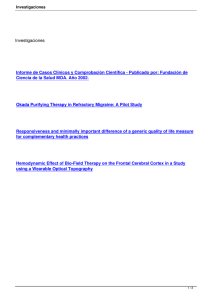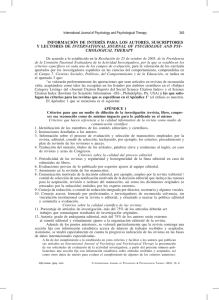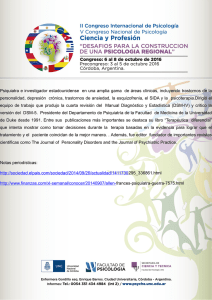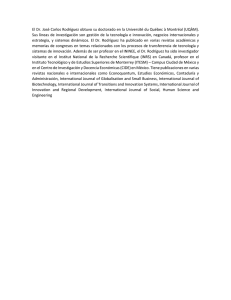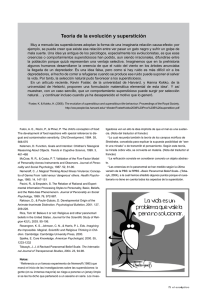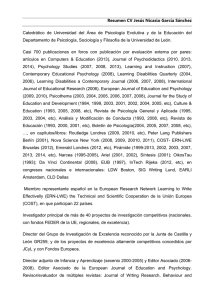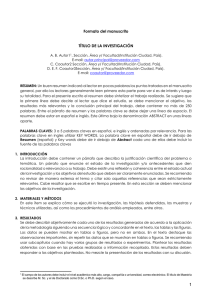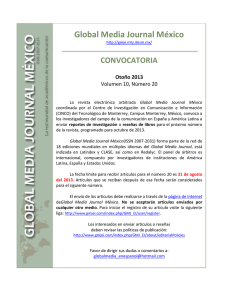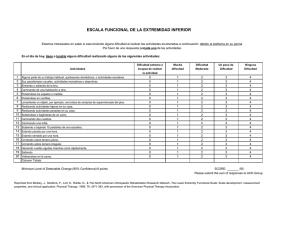Intervenciones psicológicas con apoyo empírico
Anuncio
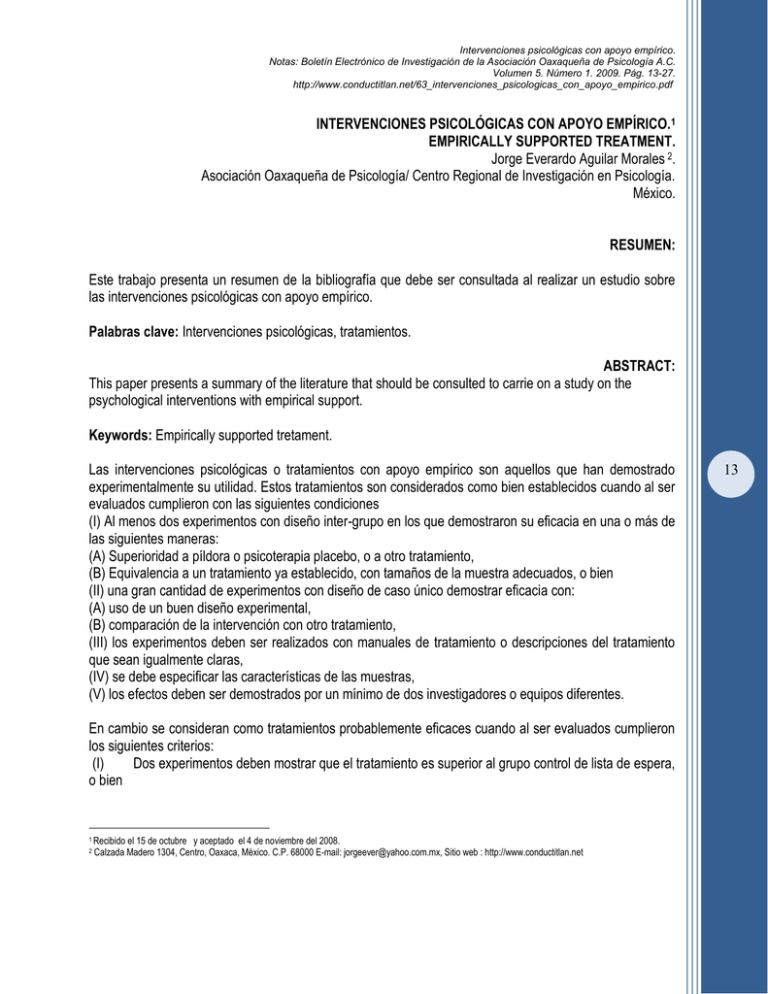
Intervenciones psicológicas con apoyo empírico. Notas: Boletín Electrónico de Investigación de la Asociación Oaxaqueña de Psicología A.C. Volumen 5. Número 1. 2009. Pág. 13-27. http://www.conductitlan.net/63_intervenciones_psicologicas_con_apoyo_empirico.pdf INTERVENCIONES PSICOLÓGICAS CON APOYO EMPÍRICO.1 EMPIRICALLY SUPPORTED TREATMENT. Jorge Everardo Aguilar Morales 2. Asociación Oaxaqueña de Psicología/ Centro Regional de Investigación en Psicología. México. RESUMEN: Este trabajo presenta un resumen de la bibliografía que debe ser consultada al realizar un estudio sobre las intervenciones psicológicas con apoyo empírico. Palabras clave: Intervenciones psicológicas, tratamientos. ABSTRACT: This paper presents a summary of the literature that should be consulted to carrie on a study on the psychological interventions with empirical support. Keywords: Empirically supported tretament. Las intervenciones psicológicas o tratamientos con apoyo empírico son aquellos que han demostrado experimentalmente su utilidad. Estos tratamientos son considerados como bien establecidos cuando al ser evaluados cumplieron con las siguientes condiciones (I) Al menos dos experimentos con diseño inter-grupo en los que demostraron su eficacia en una o más de las siguientes maneras: (A) Superioridad a píldora o psicoterapia placebo, o a otro tratamiento, (B) Equivalencia a un tratamiento ya establecido, con tamaños de la muestra adecuados, o bien (II) una gran cantidad de experimentos con diseño de caso único demostrar eficacia con: (A) uso de un buen diseño experimental, (B) comparación de la intervención con otro tratamiento, (III) los experimentos deben ser realizados con manuales de tratamiento o descripciones del tratamiento que sean igualmente claras, (IV) se debe especificar las características de las muestras, (V) los efectos deben ser demostrados por un mínimo de dos investigadores o equipos diferentes. En cambio se consideran como tratamientos probablemente eficaces cuando al ser evaluados cumplieron los siguientes criterios: (I) Dos experimentos deben mostrar que el tratamiento es superior al grupo control de lista de espera, o bien 1 Recibido 2 el 15 de octubre y aceptado el 4 de noviembre del 2008. Calzada Madero 1304, Centro, Oaxaca, México. C.P. 68000 E-mail: [email protected], Sitio web : http://www.conductitlan.net 13 Intervenciones psicológicas con apoyo empírico. Notas: Boletín Electrónico de Investigación de la Asociación Oaxaqueña de Psicología A.C. Volumen 5. Número 1. 2009. Pág. 13-27. http://www.conductitlan.net/63_intervenciones_psicologicas_con_apoyo_empirico.pdf (II) Uno o más experimentos deben cumplir los criterios de tratamiento bien establecido IA o IB, III, y IV, pero no se cumple el criterio V, o bien (III) (III) una pequeña cantidad de experimentos de diseño de caso único deben cumplir los criterios de tratamiento bien establecido. La evaluación de los tratamientos fue realizada por un Grupo de Tarea de la División 12 de la Asociación American de Psicología. La inclusión de los tratamientos que casi en su totalidad provienen de una aproximación conductual, no obedece sin embargo, a criterios de grupos o “corrientes psicológicas”,pues solo el 1% de los inscritos en dicha asociación se consideran conductistas. Su inclusión es estrictamente a partir de criterios metodológicos. El dictamen de este grupo de tarea ( que mas adelante se convertiría en una comisión permanente) fue aprobado por el consejo directivo de dicha divisón. Un grupo diferente en Inglaterra y Canadá hicieron su propia revisión con resultados similares. La siguiente es solo una lista de las intervenciones psicológicas que cuentan con apoyo empírico, aquí se agrupa la información que ya fue publicada en los reportes del Grupo de Tarea de la División 12 de la APA tratando de poner las referencias que es necesario consultar y los textos que sirven como manuales de tratamiento, de tal manera que el interesado en estudiar sobre el tema tenga un instrumento más práctico de la bibliografía que deberá consultar. Problema Ataque de pánico Intervención Terapia cognitiva conductual ANSIEDAD Y ESTRÉS Referencia Barlow, D. H., Craske, M. G., Cerny, J. A., & Klosko, J. S. (1989). Behavioral treatment of panic disorder. Behavior Therapy, 20, 261-282. Clark, D. M., Salkovskis, P.M., Hackman, A., Middleton, H., Anastasiades, P., & Gelder, M. (1994). A comparison of cognitive therapy, applied relaxation, and imipramine in the treatment of panic disorder. British Journal of Psychiatry, 164, 759-769. Mattick, R. P., Andrews, G., Hadzi-Pavlovic, D., & Christensen, H. (1990). Treatment of panic and agoraphobia: An integrative review. Journal of Nervous and Mental Disease, 178, 567-576. Manual Barlow, D.H., & Cerny, J.A. (1988). Psychological Treatment of Panic. New York: Guilford Press. Barlow, D., & Craske, M. (1994). Mastery of Your Anxiety and Panic - II. Albany, NY: Graywind Publications. Clark, D.M. (1989). Anxiety states: Panic and generalized anxiety. In K. Hawton, P. Salkovskis, J. Kirk, & D.M. Clark (Eds.) Cognitive Behavior Therapy for Psychiatric Problems. Oxford: Oxford. University Press. Salkovskis, P.M., & Clark, D.M. (1991). Cognitive treatment of panic disorder. Journal of Cognitive Psychotherapy, 3, 215-226. Hecker, J.E., & Thorpe, G.L. (1992). Agoraphobia and panic: A guide to psychological treatment. Boston: Allyn & Bacon. Salkovskis, P. M., & Clark, D. M. (1991). Cognitive treatment of panic disorder. Journal of Cognitive Psychotherapy, 3, 215-226. Ataque pánico de Relajación aplicada Öst, L. (1988). Applied relaxation vs progressive relaxation in the treatment of panic disorder. Behaviour Research and Therapy, 26, 13-22. Öst, L., & Westling, B. E. (1991). Treatment of panic disorder by applied relaxation versus cognitive therapy. Paper presented at the meeting of the European Association of Behaviour Therapy, Oslo. 14 Intervenciones psicológicas con apoyo empírico. Notas: Boletín Electrónico de Investigación de la Asociación Oaxaqueña de Psicología A.C. Volumen 5. Número 1. 2009. Pág. 13-27. http://www.conductitlan.net/63_intervenciones_psicologicas_con_apoyo_empirico.pdf Problema Ansiedad generalizada Intervención Terapia cognitiva conductual ANSIEDAD Y ESTRÉS Referencia Butler, G., Fennell, M., Robson, P., & Gelder, M. (1991). Comparison of behavior therapy and cognitive behavior therapy in the treatment of generalized anxiety disorder. Journal of Consulting and Clinical Psychology, 59, 167175. Borkovec, T. D., Mathews, A. M., Chambers, A., Ebrahimi, S., Lytle, R., & Nelson, R. (1987). The effects of relaxation training with cognitive or nondirective therapy and the role of relaxation-induced anxiety in the treatment of generalized anxiety. Journal of Consulting and Clinical Psychology, 55, 883-888. Chambless, D. L., & Gillis, M. M. (1993). Cognitive therapy of anxiety disorders. Journal of Consulting and Clinical Psychology, 61, 248-260. Ansiedad generalizada Agorafobia Relajación aplicada para la ansiedad generalizada Tratamiento exposición de Agorafobia Entrenamiento en comunicación en pareja mas exposición Fobia social Terapia cognitive conductual en grupo Manual Controlling Anxiety. Department of Psychology, Warnerford Hospital, Headington, OxfordBrown, T., O'Leary, T., & Barlow, D.H. (1994). Generalized anxiety disorder. In D.H. Barlow (Ed.), Clinical Handbook of Psychological Disorders. New York: Guilford. Zinbarg, R. E., Craske, M. G., & Barlow, D. H. (1993). Therapist's guide for the Mastery of Your Anxiety and Worry program. San Antonio, TX: Psychological Corporation. Anxiety Managment for Generalized Anxiety. Department of Psychology, Warnerford Hospital, Headington, Oxford. Barlow, D. H., Craske, M. G., Cerny, J. A., & Klosko, J. S. (1989). Behavioral treatment of panic disorder. Behavior Therapy, 20, 261-282. Borkovec, T.D., & Costello, E. (1993). Efficacy of applied relaxation and cognitive-behavioral therapy in the treatment of generalized anxiety disorder. Journal of Consulting and Clinical Psychology, 61, 611-619. Trull, T. J., Nietzel, M. T., & Main, A. (1988). The use of meta-analysis to assess the clinical significance of behavior therapy for agoraphobia. Behavior Therapy, 19, 527-538. Mattick, R. P., Andrews, G., Hadzi-Pavlovic, D., & Christensen, H. (1990). Treatment of panic and agoraphobia: An integrative review. Journal of Nervous and Mental Disease, 178, 567-576. Arnow, B.A., Taylor, C.B., Agras, W.S., & Telch, M.J. (1985). Enhancing agoraphobia treatment outcome by changing couple communication patterns. Behavior Therapy, 16, 452-467. Mattick, R. P., & Peters, L. (1988). Treatment of severe social phobia: Effects of guided exposure with and without cognitive restructuring. Journal of Consulting and Clinical Psychology, 56, 251-260. Heimberg, R. G., Dodge, C. S., Hope, D. A., Kennedy, C. R., & Zollo, L. J. (1990). Cognitive behavioral group treatment for social phobia: Comparison with a credible placebo control. Cognitive Therapy and Research, 14, 1-23 Feske, U., & Chambless, D.L. (1995). Cognitive behavioral versus exposure only treatment for social phobia: A meta-analysis. Behavior Therapy, 26, 695-720. 15 Cognitive Behavioral Group Therapy for Social Phobia. Department of Psychology, Temple University, Turner, S.M., Beidel, D.C., & Cooley, M. (1997). Social effectiveness therapy: A program for overcoming social anxiety and phobia. Toronto: Multi-Health Systems Intervenciones psicológicas con apoyo empírico. Notas: Boletín Electrónico de Investigación de la Asociación Oaxaqueña de Psicología A.C. Volumen 5. Número 1. 2009. Pág. 13-27. http://www.conductitlan.net/63_intervenciones_psicologicas_con_apoyo_empirico.pdf Problema Fobia social Intervención Tratamiento de exposición Fobia social Desensibilización sistemática Fobia específica Desensibilización sistemática Fobia específica Terapia exposición Fobia específica Fobia específica Conductas obsesivas compulsivas de Desensibilización sistemática para la fobia a animales Desensibilización sistemática para la ansiedad a hablar en público Terapia conductual ANSIEDAD Y ESTRÉS Referencia Feske, U., & Chambless, D.L. (1995). Cognitive behavioral versus exposure only treatment for social phobia: A metaanalysis. Behavior Therapy, 26, 695-720. Paul, G.L., & Shannon, D.T. (1966). Treatment of anxiety through systematic desensitization in therapy groups. Journal of Abnormal Psychology, 71, 123-135. Kazdin, A. E., & Wilcoxon, L. A. (1976). Systematic desensitization and nonspecific treatment effects: A methodological evaluation. Psychological Bulletin, 83, 729-758. Marks, I., & O'Sullivan, G. (1988). Drugs and psychological treatments for agoraphobia/panic and obsessivecompulsive disorders: A review. British Journal of Psychiatry, 153, 650-658. Manual Wolpe, J. (1990). Practice of Behavior Therapy (4th Edition). New York: Pergamon Press. Marks, I. (1978). Living with Fear. New York: McGraw Hill. Craske, M. G., Antony, M. M., & Barlow, D. H. (1997). Mastery of your specific phobia, therapist guide. San Antonio, TX: The Psychological Corporation. Kirsch, I., Tennen, H., Wickless, C., Saccone, A.J., & Cody, S. (1983). The role of expectancy in fear reduction. Behavior Therapy, 14, 520-533. Öst, L.-G. (1978). Fading vs. systematic desensitization in the treatment of snake and spider phobia. Behaviour Research and Therapy, 16, 379-389. Paul, G.L. (1967). Insight vs desensitization in psychotherapy two years after termination. Journal of Consulting Psychology, 31, 333-348. Woy, R.J., & Efran, J.S. (1972). Systematic desensitization and expectancy in the treatment of speaking anxiety. Behaviour Research and Therapy, 10, 43-49. Steketee, G., Foa, E. B., & Grayson, J. B. (1982). Recent advances in the behavioral treatment of obsessive compulsives. Archives of General Psychiatry, 39, 13651371. 16 Kozak, M., & Foa, E.B. (1997). Mastery of obsessivecompulsive disorder: A cognitivebehavioral approach. San Antonio, TX: The Psychological Corporation. Riggs, D. S. & Foa, E. B. (1993). Obsessive compulsive disorder. In D.H. Barlow (Ed.), Clinical handbook of psychological disorders. (2nd ed., pp. 180-239). New York: Guilford. Steketee, G. (1993). Treatment of Obsessive Compulsive Disorder. New York: Guilford Press. Riggs, D.S. & Foa, E.B. Obsessive compulsive disorder. In D.H. Barlow (Ed.), Clinical Handbook of Psychological Disorders. New York: Guilford. Intervenciones psicológicas con apoyo empírico. Notas: Boletín Electrónico de Investigación de la Asociación Oaxaqueña de Psicología A.C. Volumen 5. Número 1. 2009. Pág. 13-27. http://www.conductitlan.net/63_intervenciones_psicologicas_con_apoyo_empirico.pdf Problema Conductas obsesivas compulsivas Intervención Exposición con prevención de respuestas Conductas obsesivas compulsivas Terapia cognitiva Estrés Inoculación estrés Estrés posttraumático Terapia conductual Estrés posttraumático Desensibilización y reprocesamiento con movimiento ocular Estrés posttraumático Estrés posttraumático Tratamiento exposición Inoculación estrés de de del ANSIEDAD Y ESTRÉS Referencia van Balkom A.J.L.M., van Oppen, P., Vermeulen, A.W.A., Nauta, N.C.E., Vorst, H.C.M., & van Dyck, R. (1994). A meta-analysis on the treatment of obsessive compulsive disorder: A comparison of antidepressants, behaviour and cognitive therapy. Clinical Psychology Review, 14, 359381. van Oppen, P., de Haan, E., van Balkom, A.J.L.M., Spinhoven, P., Hoogduin, K., & van Dyck, R. (1995). Cognitive therapy and exposure in vivo in the treatment of obsessive compulsive disorder. Behaviour Research and Therapy, 33, 379-390. Saunders, T., Driskell, J.E., Hall, J., Salas, E. (1996). The effect of stress inoculation training on anxiety and performance. Journal of Occupational Health Psychology 1, 170-186. Foa, E. B., Rothbaum, B. O., Riggs, D. S., & Murdock, T. B. (1991). Treatment of posttraumatic stress disorder in rape victims: A comparison between cognitive-behavioral procedures and counseling. Journal of Consulting and Clinical Psychology, 59, 715-723. Rothbaum, B.O. (in press). A controlled study of eye movement desensitization and reprocessing in the treatment of posttraumatic stress disordered sexual assault victims. Bulletin of the Menninger Clinic Wilson, S.A., Becker, L.A., & Tinker, R.H. (1995). Eye movement desensitization and reprocessing (EMDR) treatment for psychologically traumatized individuals. Journal of Consulting and Clinical Psychology, 63, 928937. Foa, E. B., Rothbaum, B. O., Riggs, D. S., & Murdock, T. B. (1991). Treatment of posttraumatic stress disorder in rape victims: A comparison between cognitive-behavioral procedures and counseling. Journal of Consulting and Clinical Psychology, 59, 715723. Keane, T.M., Fairbank, J.A., Caddell, J.M., & Zimering, R.T. (1989). Implosive (flooding) therapy reduces symptoms of PTSD in Vietnam combat veterans. Behavior Therapy, 20, 245-260. Foa, E. B., Rothbaum, B. O., Riggs, D. S., & Murdock, T. B. (1991). Treatment of posttraumatic stress disorder in rape victims: A comparison between cognitive-behavioral procedures and counseling. Journal of Consulting and Clinical Psychology, 59, 715723. Manual Meichenbaum, D. (1985). Stress inoculation training. New York: Pergamon Press. Clinical Handbook/Therapist Manual on PTSD. Donald Meichenbaum. University of Waterloo, Department of Psychology. 17 Intervenciones psicológicas con apoyo empírico. Notas: Boletín Electrónico de Investigación de la Asociación Oaxaqueña de Psicología A.C. Volumen 5. Número 1. 2009. Pág. 13-27. http://www.conductitlan.net/63_intervenciones_psicologicas_con_apoyo_empirico.pdf Problema Abuso de cocaína Intervención Terapia conducutal Dependencia de cocaína Terapia conductual prevención recaídas Dependencia de opiaceos Terapia dinámica breve Dependencia de opiaceos Terapia cognitiva Retiro de la benzodiacepina para ataques de pánico Terapia cognitivo conducutal Abuso alcohol del con de Refuerzo de la comunidad Abuso alcohol del Exposición a señales mas internamiento Abuso alcohol del Terapia marital conductual + disulfiram Abuso alcohol del Habilidades sociales internamiento e ABUSO Y DEPENDENCIA DE SUSTANCIAS QUÍMICAS Referencia Higgins, S.T., Budney, A.J., Bickel, W.K., Hughes, J.R., Foeg, F., & Badger, G. (1993). Achieving cocaine abstinence with a behavioral approach. American Journal of Psychiatry, 150, 763-769. Carroll, K.M., Rounsaville, B.J., Gordon, L.T., Nich, C., Jatlow, P., Bisighini, R.M., & Gawin, F.H. (1994). Psychotherapy and pharmacology for ambulatory cocaine abusers. Archives of General Psychiatry, 51, 177-187. Woody, G. E., Luborsky, L., McLellan, A. T., & O.Brien, C. P. (1990). Corrections and revised analyses for psychotherapy in methadone maintenance patients. Archives of General Psychiatry, 47, 788-789. Carroll, K.M., Rounsaville, B.J., Gordon, L.T., Nich, C., Jatlow, P., Bisighini, R.M., & Gawin, F.H. (1994). Psychotherapy and pharmacology for ambulatory cocaine abusers. Archives of General Psychiatry, 51, 177-187. Otto, M.W., Pollack, M.H., Sachs, G.S., Reiter, S.R., Meltzer-Brody, S., Rosenbaum, J.F. (1993). Discontinuation of benzodiazepine treatment: Efficacy of cognitive behavioral therapy for patients with panic disorder. American Journal of Psychiatry, 150, 14851490. Spiegel, D.A., Bruce, T.J., Gregg, S.F., & Nuzzarello, A. (1994). Does cognitive behavior therapy assist slow-taper alprazolam discontinuation in panic disorder? American Journal of Psychiatry, 151, 876-881. Azrin, N.H. (1976). Improvements in the CR approach to alcoholism. Behaviour Research and Therapy, 14, 339348. Hunt, G.M., & Azrin, N.J. (1973). A community reinforcement approach to alcoholism. Behaviour Research and Therapy, 11, 91-104. Drummond, D.C., & Glautier, S. (1994). A controlled trial of cue exposure treatment in alcohol dependence. Journal of Consulting and Clinical Psychology, 62, 809817. O.Farrell, T.J., Cutter, H.S.G., Choquette, K.A., Floyd, F.J., & Bayog, R.D. (1992). Behavioral marital therapy for male alcoholics: Marital and drinking adjustment during the two years after treatment. Behavior Therapy, 23, 529-549. O.Farrell, T.J., Cutter, H.S.G., & Floyd, F.J. (1985). Evaluating behavioral martial therapy for male alcoholics: Effects on marital adjustment and communication from before to after treatment. Behavior Therapy, 16, 147-167. Eriksen, L., Bjornstad, S., & Gotestam, K.G. (1986). Social skills training in groups for alcoholics: One-year treatment outcome for groups and individuals. Addictive Behaviors, 11, 309-329. Manual 18 Intervenciones psicológicas con apoyo empírico. Notas: Boletín Electrónico de Investigación de la Asociación Oaxaqueña de Psicología A.C. Volumen 5. Número 1. 2009. Pág. 13-27. http://www.conductitlan.net/63_intervenciones_psicologicas_con_apoyo_empirico.pdf Problema Depresión Intervención Terapia conductual Depresión Terapia cognitiva Depresión Terapia Interpersonal de Klerman y Weismann Depresión Psicoeduación Depresión Terapia dinámica breve Depresión Terapia cognitiva para pacientes geriátricos Depresión Terapia de reminiscencia DEPRESIÓN Referencia Jacobson, N.S., Dobson, K.S., Truax, P.A., Addis, M.E., Koerner, K., Gollan, J.K., Gortner, E., & Prince, S.E. (1996). A component analysis of cognitive-behavioral treatment for depression.Journal of Consulting and Clinical Psychology, 62, 295-304. McLean, P.D., & Hakstian, A.R. (1979). Clinical depression: Comparative efficacy of outpatient treatments. Journal of Consulting and Clinical Psychology, 47, 818-836. Dobson, K. S. (1989). A meta-analysis of the efficacy of cognitive therapy for depression. Journal of Consulting and Clinical Psychology, 57, 414-419. DiMascio, A., Weissman, M. M., Prusoff, B. A., Neu, C., Zwilling, M., & Klerman, G. L. (1979). Differential symptom reduction by drugs and psychotherapy in acute depression. Archives of General Psychiatry, 36, 14501456. Elkin, I., Shea, M. T., Watkins, J. T., Imber, S. D., Sotsky, S. M., Collins, J. F., Glass, D. R., Pilkonis, P. A., Leber, W. R., Docherty, J. P., Fiester, S. J., & Parloff, M. B. (1989). Archives of General Psychiatry, 46, 971-982. Lewinsohn, P. M., Hoberman, H. M., & Clarke, G. N. (1989). The Coping With Depression Course: Review and future directions. Canadian Journal of Behavioural Science, 21, 470-493. Gallagher-Thompson, D., & Steffen, A.M. (1994). Comparative effects of cognitive-behavioral and brief dynamic therapy for depressed family caregivers. Journal of Consulting and Clinical Psychology, 62, 543-549. Scogin, F., & McElreath, L. (1994). Efficacy of psychosocial treatments for geriatric depression: A quantitative review. Journal of Consulting and Clinical Psychology, 62, 69-74. Arean, P.A., Perri, M.G., Nezu, A.M., Schein, R.L., Christopher, F., & Joseph, T.X. (1993). Comparative effectiveness of social problem-solving therapy and reminiscence therapy as treatments for depression in older adults. Journal of Consulting and Clinical Psychology, 61, 1003-1010. Scogin, F., & McElreath, L. (1994). Efficacy of psychosocial treatments for geriatric depression: A quantitative review. Journal of Consulting and Clinical Psychology, 62, 69-74. Manual Beck, A.T., Rush, A.J., Shaw, B.F., & Emery, G. (1979). Cognitive Therapy of Depression. New York: Guilford. Klerman, G.L., Weissman, M.M., Rounsaville, B.J., & Chevron, E.S. (1984). Interpersonal Psychotherapy of Depression. New York: Basic Books. 19 Intervenciones psicológicas con apoyo empírico. Notas: Boletín Electrónico de Investigación de la Asociación Oaxaqueña de Psicología A.C. Volumen 5. Número 1. 2009. Pág. 13-27. http://www.conductitlan.net/63_intervenciones_psicologicas_con_apoyo_empirico.pdf Problema Depresión Depresión Problema Dolor de cabeza crónico Migranaña Intervención Terapia de autocontrol Terapia solución problemas en de Intervención Terapia conductual Biofeedback térmico con entrenamiento autógeno en relajación DEPRESIÓN Referencia Fuchs, C.Z., & Rehm, L.P. (1977). A self-control behavior therapy program for depression. Journal of Consulting and Clinical Psychology, 45, 206-215. Manual Rehm, L.P., Fuchs, C.Z., Roth, D.M., Kornblith, S.J., & Romano, J.M. (1979). A comparison of self-control and assertion skills treatments of depression. Behavior Therapy, 10, 429-442. Nezu, A.M. (1986). Efficacy of a social problem-solving therapy approach for unipolar depression. Journal of Consulting and Clinical Psychology, 54, 196-202. Nezu, A.M., & Perri, M.G. (1989). Social problem-solving therapy for unipolar depression: An initial dismantling investigation. Journal of Consulting and Clinical Psychology, 57, 408413. PROBLEMAS DE SALUD Referencia Blanchard, E. B., Andrasik, F., Ahles, T. A., Teders, S. J., & O'Keefe, D. (1980). Migraine and tension headache: A meta-analytic review. Behavior Therapy, 11, 613-631. Blanchard, E. B., Schwarz, S. P., & Radnitz, C. (1987). Psychological assessment and treatment of irritable bowel syndrome. Behavior Modification, 11, 348-372. Holroyd, K.A., & Penzien, D.B. (1990). Pharmacological versus nonpharmacological prophylaxis of recurrent migraine headache: A meta-analytic review of clinical trials. Pain, 42, 1-13. Blanchard, E.B., Theobold, D.E., Williamson, D.A., Silver, B.V., & Brown, D.A. (1978). Temperature biofeedback in the treatment of migraine headaches. Archives of General Psychiatry, 35, 581588. Sargent, J., Solbach, P., Coyne, L., Spohn, H., & Segerson, J. (1986). Results of a controlled experimental outcome study of non-drug treatment for the control of migraine headache. Journal of Behavioral Medicine, 9, 291-323. Manual Blanchard, E.B., & Andrasik, F. (1985). Management of Chronic Headache: A Psychological Approach. Elmsford, NY: Pergamon Press. 20 Intervenciones psicológicas con apoyo empírico. Notas: Boletín Electrónico de Investigación de la Asociación Oaxaqueña de Psicología A.C. Volumen 5. Número 1. 2009. Pág. 13-27. http://www.conductitlan.net/63_intervenciones_psicologicas_con_apoyo_empirico.pdf Problema Dolor crónico Intervención Terapia cognitive conductual PROBLEMAS DE SALUD Referencia Keefe, F. J., Dunsmore, J., & Burnett, R. (1992). Behavioral and cognitive-behavioral approaches to chronic pain: Recent advances and future directions. Journal of Consulting and Clinical Psychology, 60, 528-536. Parker, J.C., Frank, R.G., Beck, N.C., Smarr, K.L., Buescher, K.L, Phillips, L.R., Smith, E.I., Anderson, S.K., & Walker, S.E. (1988). Pain management in rheumatoid arthritis patients: A cognitivebehavioral approach. Arthritis and Rheumatism, 31, 593-601. Dolor crónico Terapia cognitivo conductual mas terapia física Dolor crónico Biofeedback electromiográfico Dolor cróncio Terapia conducutal operante Dolor crónico (espalda) Terapia cognitivo conductual Manual Cognitive Behavioral Treatment for Arthritis Pain. Duke Medical Center, Turk, D.C., Meichenbaum, D., & Genest, M. (1983). Pain and behavioral medicine: A cognitive-behavioral perspective. New York:Guilford Press. Keefe, F. J., Beaupre, P. M., & Gil, K. M. (1997). Group therapy for patients with chronic pain. In R. J. Gatchel & D. C. Turk (Eds.) Psychological treatments for pain: A practitioner's handbook. New York: Guilford Press. Nicholas, M.K., Wilson, P.H., & Goyen, J. (1991). Operant-behavioral and cognitive-behavioral treatment for chronic low back pain. Behaviour Research and Therapy, 29, 225-238. Flor, H., & Birbaumer, N. (1993). Comparison of the efficacy of electromyographic biofeedback, cognitivebehavioral therapy, and conservative medical interventions in the treatment of chronic musculoskeletal pain. Journal of Consulting and Clinical Psychology,61, 653-658. Newton-John, T.R.O., Spence, S.H., & Schotte, D. (1995). Cognitivebehavioral therapy versus EMG biofeedback in the treatment of chronic low back pain. Behaviour Research and Therapy, 33, 691-697 Turner, J.A., & Clancy, S. (1988). Comparison of operant behavioral and cognitive-behavioral group treatment for chronic low back pain. Journal of Consulting and Clinical Psychology, 56, 261266. Turner, J.A., Clancy, S., McQuade, K.J., & Cardenas, D.D. (1990). Effectiveness of behavioral therapy for chronic low back pain: A component analysis. Journal of Consulting and Clinical Psychology, 58, 573-579. Turner, J.A., & Clancy, S. (1988). Comparison of operant behavioral and cognitive-behavioral group treatment for chronic low back pain. Journal of Consulting and Clinical Psychology, 56, 261266. 21 Intervenciones psicológicas con apoyo empírico. Notas: Boletín Electrónico de Investigación de la Asociación Oaxaqueña de Psicología A.C. Volumen 5. Número 1. 2009. Pág. 13-27. http://www.conductitlan.net/63_intervenciones_psicologicas_con_apoyo_empirico.pdf Problema Bulimia Intervención Terapia Cognitivo conductual PROBLEMAS DE SALUD Referencia Agras, W.S., Schneider, J.A., Arnow, B., Raeburn, S.D., & Telch, C.F. (1989). Cognitive-behavioral and responseprevention treatments for bulimia nervosa. Journal of Consulting and Clinical Psychology, 57, 215-221. Thackwray, D.E., Smith, M.C., Bodfish, J.W., & Meyers, A.W. (1993). A comparison of behavioral and cognitivebehavioral interventions for bulimia nervosa. Journal of Consulting and Clinical Psychology, 61, 639-645. Fairburn, C. G., Jones, R., Peveler, R. C., Hope, R. A., O'Conner, M. (1993). Psychotherapy and bulimia nervosa: Longer-term effects of interpersonal psychotherapy,behavior therapy, and cognitive behavior therapy.Archives of General Psychiatry, 50, 419-428. Bulimia Fumar Fumar Terapia interpersonal Terapia cognitiva conductual multicomponente con prevención de recaídas Reducción programada del hábito de fumar con terapia conductual multicomponente Wilfley, D. E., Agras, W. S., Telch, C. F., Rossiter, E. M., Schneider, J. A., Cole, A. G., Sifford, L., & Raeburn, S. D. (1993). Group cognitive-behavioral therapy and group interpersonal psychotherapy for the nonpurging bulimic individual: A controlled comparison. Journal of Consulting and Clinical Psychology, 61, 296-305. Fairburn, C. G., Jones, R., Peveler, R. C., Hope, R. A., O.Conner, M. (1993). Psychotherapy and bulimia nervosa: Longer-term effects of interpersonal psychotherapy, behavior therapy, and cognitive behavior therapy. Archives of General Psychiatry, 50, 419-428 Hill, R.D., Rigdon, M., & Johnson, S. (1993). Behavioral smoking cessation treatment for older chronic smokers. Behavior Therapy, 24, 321-329. Stevens, V.J., & Hollis, J.F. (1989). Preventing smoking relapse, using an individually tailored skills-training technique. Journal of Consulting and Clinical Psychology, 57, 420-424. Cinciripini, P.M., Lapitsky, L.G., Seay, S., Wallfisch, A., Kitchens, K., & van Vunakis, H. (1995). The effects of smoking schedules on cessation outcome: Can we improve on common methods of gradual and abrupt nicotine withdrawal? Journal of Consulting and Clinical Psychology, 63, 388-399. Cinciripini, P.M., Lapitsky, L.G., Wallfisch, A., Mace, R., Nezami, E., & van Vunakis, H. (1994). An evaluation of a multicomponent treatment program involving scheduled smoking and relapse prevention procedures: Initial findings. Addictive Behaviors, 19, 13-22 Manual Agras, W.S., & Apple, R.F. (1997). Overcoming eating disorders: A cognitive behavioral treatment for bulimia nervosa and binge-eating disorder. San Antonio, TX: The Psychological Corporation. Fairburn, C.G. (1985). Cognitive-behavioral treatment for bulimia. In D.M. Garner and P.E. Garfinkel (Eds.) Handbook of Psychotherapy for Anorexia Nervosa and Bulimia. New York: Plenum Press. Fairburn, C.G., Marcus, M.D., & Wilson, G.T. (1993). Cognitive-behavioral therapy for binge eating and bulimia nervosa. In C.G.Fairburn & G.T. Wilson (Eds.) Binge Eating: Nature, Assessment, and Treatment. New York: Guilford Press. Fairburn, C.G. (1993). for bulimia nervosa. Weissman (Eds.) New Therapy. Washington, Press. Interpersonal psychotherapy In G.L. Klerman & M.M. Applications of Interpersonal DC: American Psychiatric 22 Intervenciones psicológicas con apoyo empírico. Notas: Boletín Electrónico de Investigación de la Asociación Oaxaqueña de Psicología A.C. Volumen 5. Número 1. 2009. Pág. 13-27. http://www.conductitlan.net/63_intervenciones_psicologicas_con_apoyo_empirico.pdf Problema Obesidad infantil Trastorno atracón por Obesidad Síndrome del cólon irritable Dolor por enfermedad de célula falciforme (sickle cell disease pain) Intervención Terapia conductual Terapia cognitiva conductual Hipnosis y terapia cognivito conductual Terapi cognitiva multicomponenete Terapia cognitivoconductual multicomponente PROBLEMAS DE SALUD Referencia Epstein, L.H., Valoski, A., Wing, R.R., & McCurley, J. (1994). Tenyear outcomes of behavioral family-based treatment for childhood obesity. Health Psychology, 13, 373-383. Manual Wheeler, M.E., & Hess, K.W. (1976). Treatment of juvenile obesity by successive approximation control of eating. Journal of Behavior Therapy and Experimental Psychiatry, 7, 235-241. Telch, C.F., Agras, W.S., Rossiter, E.M., Wilfley, D., & Kenardy, J. (1990). Group cognitive-behavioral treatment for the nonpurging bulimic. Journal of Consulting and Clinical Psychology, 58, 629-635. Wilfley, D. E., Agras, W. S., Telch, C. F., Rossiter, E. M., Schneider, J. A., Cole, A. G., Sifford, L., & Raeburn, S. D. (1993). Group cognitive-behavioral therapy and group interpersonal psychotherapy for the nonpurging bulimic individual: A controlled comparison. Journal of Consulting and Clinical Psychology, 61, 296-305. Bolocofsky, D.N., Spinler, D., & Coulthard-Morris, L. (1985). Effectiveness of hypnosis as an adjunct to behavioral weight management. Journal of Clinical Psychology, 41, 35-41. Wilfley, D. E., Agras, W. S., Telch, C. F., Rossiter, E. M., Schneider, J. A., Cole, A. G., Sifford, L., & Raeburn, S. D. (1993). Group cognitive-behavioral therapy and group interpersonal psychotherapy for the nonpurging bulimic individual: A controlled comparison. Journal of Consulting and Clinical Psychology, 61, 296-305. Lynch, P.M., & Zamble, E. (1989). A controlled behavioral treatment study of irritable bowel syndrome. Behavior Therapy, 20, 509-523. Payne, A., & Blanchard, E.B. (1995). A controlled comparison of cognitive therapy and self-help support groups in the treatment of irritable bowel syndrome. Journal of Consulting and Clinical Psychology, 63, 779-786. Gil, K.M., Wilson, J.J., Edens, J.L., Webster, D.A., Abrams, M.A., Orringer, E., Grant, M., Clark, W.C., & Janal, M.N. (1996). The effects of cognitive coping skills training on coping strategies and experimental pain sensitivity in African American adults with sickle cell disease. Health Psychology, 15, 3-10. 23 Intervenciones psicológicas con apoyo empírico. Notas: Boletín Electrónico de Investigación de la Asociación Oaxaqueña de Psicología A.C. Volumen 5. Número 1. 2009. Pág. 13-27. http://www.conductitlan.net/63_intervenciones_psicologicas_con_apoyo_empirico.pdf Problema Síndrome de Raynaud Intervención Biofeedback térmico Problema Enuresis Intervención Modificación de conducta PROBLEMAS DE SALUD Referencia Freedman, R.R., Ianni, P., & Wenig, P. (1983). Behavioral treatment of Raynaud.s disease. Journal of Consulting and Clinical Psychology, 51, 539-549. PROBLEMAS DE CONDUCTA EN NIÑOS Referencia Houts, A.C., Berman, J.S., & Abramson, H. (1994). Effectiveness of psychological and pharmacological treatments for nocturnal enuresis. Journal of Consulting and Clinical Psychology, 62, 737-745. Kupfersmid, J. (1989). Treatment of nocturnal enuresis: A status report. The Psychiatric Forum, 14, 37-46. Conducta oposicionista Terapia conducutal Walter, H. I., & Gilmore, S. K. (1973). Placebo versus social learning effects in parent training procedures designed to alter the behavior of aggressive boys. Behavior Therapy, 4, 361-377. Wells, K. C., & Egan, J. (1988). Social learning and systems family therapy for childhood oppositional disorder: Comparative treatment outcome. Comprehensive Psychiatry, 29, 138-146. Manual Manual Azrin, N.H. & Besalel, V.B. (1979). A Parent's Guide To Bedwetting Control. New York: Pocket Books. Full Spectrum Home Training for Nocturnal Enuresis. Department of Psychology, University of Memphis, Forehand, R., & McMahon, R. J. (1981). Helping the noncompliant child: A clinician's guide for parent training. New York: Guilford. Kozloff, M. A. (1979). A program for families of children with learning and behavior problems. New York: Wiley. Parent-Child Interaction Therapy. Department of Clinical and Health Psychology, University of Florida, Patterson, G. R., Reid, J. B., Jones, R. R., & Conger, R. E. (1975). A social learning approach to family interaction (Vol. 1). Eugene, OR: Castalia Publishing. Patterson, G. R., & Forgatch, M. (1987). Parents and adolescents living together --Part 1: The basics. Eugene, OR: Castalia Publishing. Forgatch, M., & Patterson, G.R. (1987). Parents and adolescents living together -Part 2: Family problem solving. Eugene, OR: Castalia Publishing. Sanders, M. R., & Dadds, M. R. (1993). Behavioral family intervention. Needham Heights, MA: Allyn & Bacon. Encopresis Modificación conducta de O.Brien, S., Ross, L.V., & Christophersen, E.R. (1986). Primary encopresis: Evaluation and treatment. Journal of Applied Behavior Analysis, 19, 137-145. Wright, L., & Walker, C. E. (1978). A simple behavioral treatment program for psychogenic encopresis. Behaviour Research and Therapy, 16, 209-212. 24 Intervenciones psicológicas con apoyo empírico. Notas: Boletín Electrónico de Investigación de la Asociación Oaxaqueña de Psicología A.C. Volumen 5. Número 1. 2009. Pág. 13-27. http://www.conductitlan.net/63_intervenciones_psicologicas_con_apoyo_empirico.pdf Problema Ansiedad Intervención Terapia cognitive conducutal para la ansiedad de separación, desorden de evitación y sobreansiedad Ansiedad Entrenamiento en el manejo de la ansiedad en la familia Fobia simple Exposición Problema Conflicto marital Intervención Terapia conductual Conflicto marital Conflicto marital Terapia de pareja enfocada en la emoción Terapia marital orientada al insight PROBLEMAS DE CONDUCTA EN NIÑOS Referencia Kendall, P.C. (1994). Treating anxiety disorders in children: Results of a randomized clinical trial. Journal of Consulting and Clinical Psychology, 62, 100-110. Kendall, P.C., Flannery-Schroeder, E., Panichelli-Mindel, S.M., Southam-Gerow, M., Henin, A., & Warman, M. (1997). Therapy for youths with anxiety disorders: A second randomized clinical trial. Journal of Consulting and Clinical Psychology, 65, 366-380 Barrett, P.M., Dadds, M.R., & Rapee, R.M. (1996). Family treatment of childhood anxiety: A controlled trial. Journal of Consulting and Clinical Psychology, 64, 333-342. Menzies, R.G., & Clarke, J.C. (1993). A comparison of in vivo and vicarious exposure in the treatment of childhood water phobia. Behaviour Research and Therapy, 31, 9-15. PROBLEMAS MARITALES Referencia Azrin, N. H., Bersalel, A., Bechtel, R., Michalicek, A., Mancera, M., Carroll, D., Shuford, D., & Cox, J. (1980). Comparison of reciprocity and discussion-type counseling for marital problems. American Journal of Family Therapy, 8, 21-28. Jacobson, N. S., & Follette, W. C. (1985). Clinical significance of improvement resulting from two behavioral marital therapy components. Behavior Therapy, 16, 249262. James, P.S. (1991). Effects of a communication training component added to an emotionally focused couples therapy. Journal of Marital and Family Therapy, 17, 263-275. Johnson, S. M., & Greenberg, L. S. (1985). Differential effects of experiential and problem-solving interventions in resolving marital conflict. Journal of Consulting and Clinical Psychology, 53, 175-184. Snyder, D.K., & Wills, R.M. (1989). Behavioral versus insightoriented marital therapy: Effects on individual and interspousal functioning. Journal of Consulting and Clinical Psychology, 57, 39-46. Manual Manual Jacobson, N.S., & Margolin, G. (1979). Marital therapy: Strategies based on Social Learning and Behavior Exchange Principles. New York: Brunner/Mazel. Baucom, D.H., & Epstein, N. (1990). CognitiveBehavioral Marital Therapy. New York: Brunner/Mazel. 25 Intervenciones psicológicas con apoyo empírico. Notas: Boletín Electrónico de Investigación de la Asociación Oaxaqueña de Psicología A.C. Volumen 5. Número 1. 2009. Pág. 13-27. http://www.conductitlan.net/63_intervenciones_psicologicas_con_apoyo_empirico.pdf Problema Disfunciones sexuales DISFUNCIONES SEXUALES Referencia Auerbach, R., & Kilmann, P. R. (1977). The effects of group systematic desensitization on secondary erectile failure. Behavior Therapy, 8, 330-339. Intervención Terapia conducutal Deseo Sexual femenino hipoactivo Terapia combinada Hulbert Deseo Sexual femenino hipoactivo Terapia marital y sexual combinada de Zimmer Disfunción orgásmica femenina Terapia sexual de Masteres & Johnson Problema Enfermedad mental crónica Intervención Economía de fichas de LoPiccolo, J., & Stock, W. E. (1986). Treatment of sexual dysfunction. Journal of Consulting and Clinical Psychology, 54, 158-167. Hurlbert, D.F., White, C.L., & Powell, R.D. (1993). Orgasm consistency training in the treatment of women reporting hypoactive sexual desire: An outcome comparison of women-only groups and couple-only groups. Journal of Behavior Therapy and Experimental Psychiatry, 24, 3-13. Zimmer, D. (1987). Does marital therapy enhance the effectiveness of treatment for sexual dysfunction? Journal of Sex and Marital Therapy, 13, 193-209. Everaerd, W., & Dekker, J. (1981). A comparison of sex therapy and communication therapy: Couples complaining of orgasmic dysfunction. Journal of Sex and Marital Therapy, 7, 278-289. OTROS Referencia Liberman, R. P. (1972). Behavioral modification of schizophrenia: A review. Schizophrenia Bulletin, 1(6), 3748. Hogarty, G. E., Anderson, C. M., Reiss, D. J., Kornblith, S. J., Greenwald, D. P., Javna, C. D., & Madonia, M. J. (1986). Family psychoeducation, social skills training, and maintenance chemotherapy in the aftercare treatment of schizophrenia: I. One-year effects of a controlled study on relapse and expressed emotion. Archives of General Psychiatry, 43, 633-642. Falloon, R. H., Boyd, J. L., McGill, C. W., Williamson, M., Razani, A., Moss, H. B., Giulderman, A. M., & Simpson, G. M. (1985). Family management in the prevention of morbidity of schizophrenia: Clinical outcome of a twoyear longitudinal study. Archives of General Psychiatry, 42, 887-896. Manual Manual Ayllon, T., & Azrin, N. (1968). The token economy: A motivational system for therapy and rehabilitation. New York: Appleton-Century- Crofts. 26 Intervenciones psicológicas con apoyo empírico. Notas: Boletín Electrónico de Investigación de la Asociación Oaxaqueña de Psicología A.C. Volumen 5. Número 1. 2009. Pág. 13-27. http://www.conductitlan.net/63_intervenciones_psicologicas_con_apoyo_empirico.pdf Problema Esquizforenia PROBLEMAS DE CONDUCTA EN NIÑOS Referencia Falloon, I.R.H., Boyd, J.L., McGill, C.W., Williamson, M., Razani, J., Moss, H.B., Gilderman, A.M., & Simpson, G.M. (1985). Family management in the prevention of morbidity of schizophrenia: Clinical outcome of a two year longitudinal study. Archives of General Psychiatry, 42, 887-896. Intervención Intervención familiar Esquizofrenia Entrenamiento en habilidades sociales Enfermedades mentales graves Empleo apoyo Ofensores sexuales Modificación conducta Personalidad borderline Terapia dialéctica conductual Habitos deseados no Terapia conductual con de Manual Randolph, E.T., Eth, S., Glynn, S., Paz, G.B., Leong, G.B., Shaner, A.L., Strachan, A., Van Vort, W., Escobar, J., & Liberman, R.P. (1994). Behavioural family management in schizophrenia: Outcome from a clinic-based intervention. British Journal of Psychiatry, 144, 501-506. Marder, S.R., Wirshing, W.C., Mintz, J., McKenzie, J., Johnston, K., Eckman, T.A., Lebell, M., Zimmerman, K., & Liberman, R.P. (1996). Two-year outcome of social skills training and group psychotherapy for outpatients with schizophrenia. American Journal of Psychiatry, 153, 1585-1592. Drake, R.E., McHugo, G.J., Becker, D.R., Anthony, W.A., & Clark, R.E. (1996). The New Hampshire supported employment study. Journal of Consulting and Clinical Psychology, 64, 391399. Marshall, W. L., Jones, R., Ward, T., Johnston, P., & Barbaree, H. E. (1991). Treatment outcome with sex offenders. Clinical Psychology Review, 11, 465-485 Linehan, M. M., Armstrong, H. E., Suarez, A., Allmon, D., & Heard, H. L. (1991). Cognitive-behavioral treatment of chronically parasuicidal borderline patients. Archives of General Psychiatry, 48, 1060-1064. Azrin, N. H., Nunn, R. G., & Frantz, S. E. (1980). Habit reversal vs. negative practice treatment of nailbiting. Behaviour Research and Therapy, 18, 281-285. Azrin, N. H., Nunn, R. G., & Frantz-Renshaw, S. (1980). Habit reversal treatment of thumbsucking. Behaviour Research and Therapy, 18, 395-399. REFERENCIAS Chambless, D. L., & Ollendick, T. H. (2001). Empirically supported psychological interventions: Controversies and evidence. Annual Review of Psychology, 52, 685-716. Chambless DL, Baker M, Baucom DH, Beutler LE, Calhoun KS, et al. 1998. Update on empirically validated-therapies, II. Clin. Psychol. 51(1):3-16 Woody, S.R. & Sanderson, W.C. (1998). Manuals for empirically supported treatments: 1998 update from the task force on psychological interventions. The Clinical Psychologist, 51, 17-21. 27
